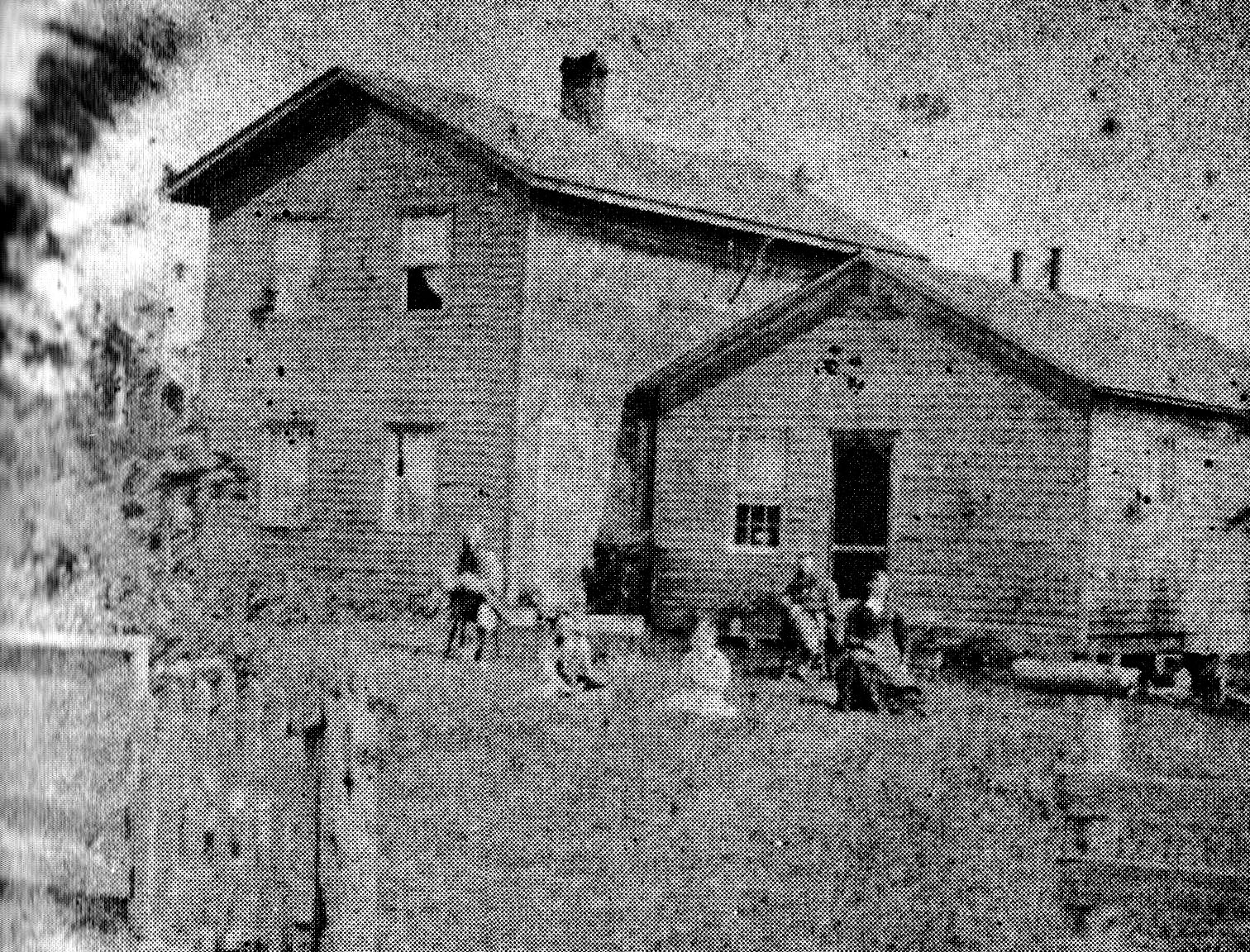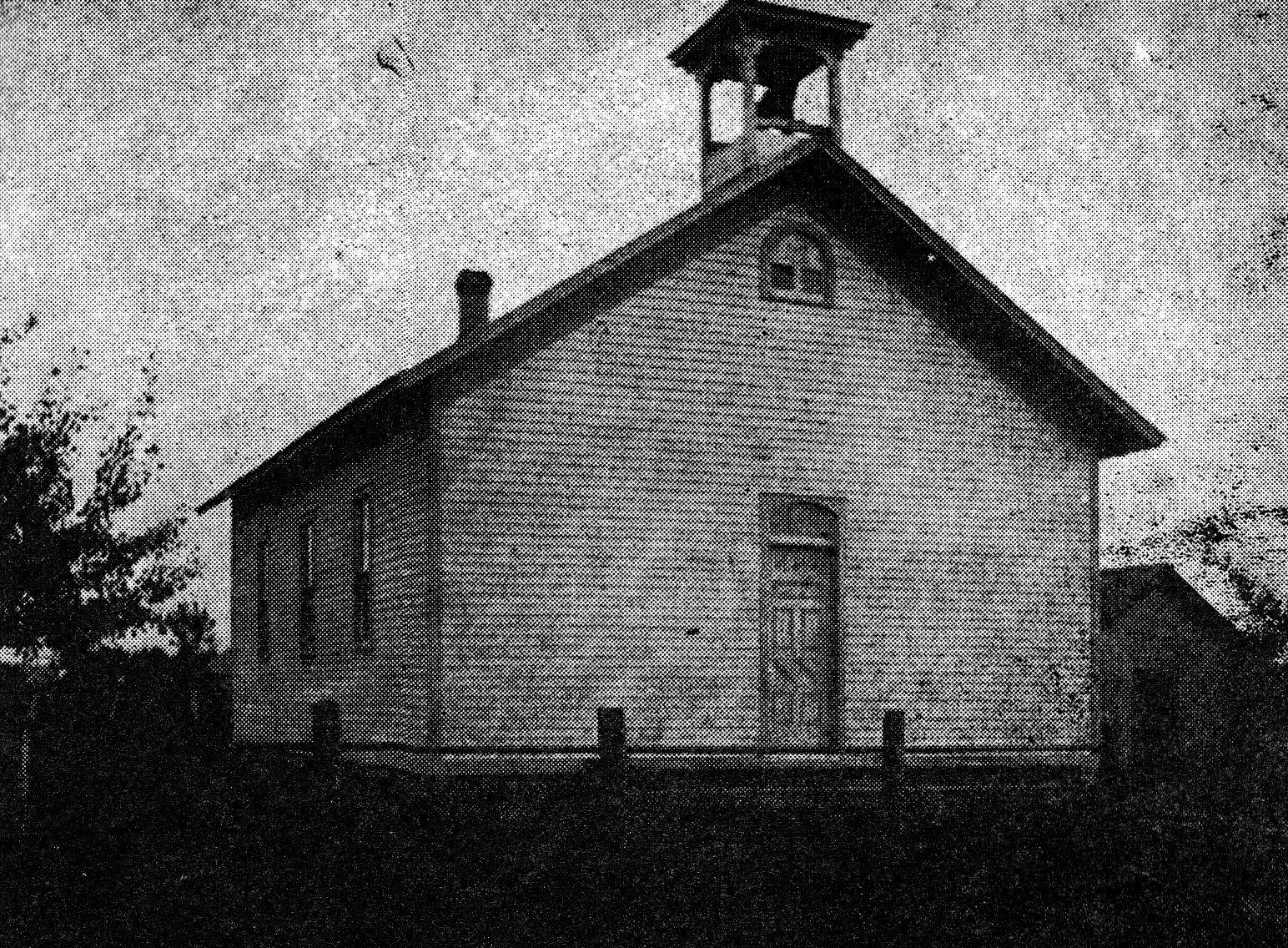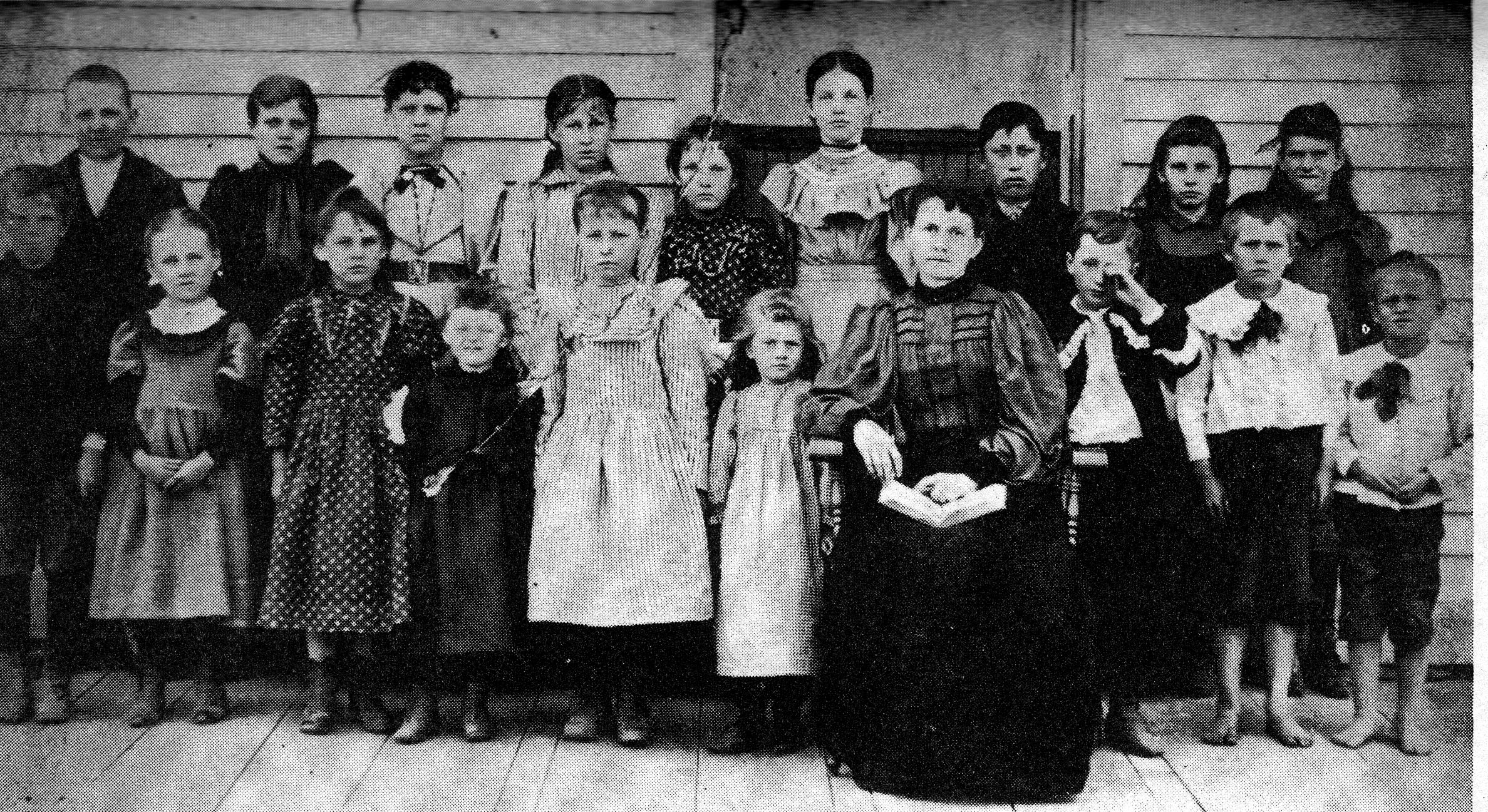
BARNEY SCHOOL DISTRICT NO. 7

| The smaller building was the second Barney School house.
This was moved to the Winegar's farm and placed
next to their home. It was used as part of their home. In the foreground is Great Grandfather, Issac Winegar. By the door, Grandfather and Grandmother Milton Issac Winegar. The little girl is Blanche and her brother, Milton. Blanche Winegar was Ralph Young's mother. |

Barney Third School House

Barney School - 1897
| Back Row, Left to Right -- Leon Hamm, Mamie Hintz, Ola Irwin, Jessie Rackett,
Loa Irwin, Loa Winegar, Claud Syerefi, Alice Ball, Metta Ball Front Row, Left to Right: -- Earl Ball, Caroline Hintz, Ada Irwin, Rose Hamm, Irene Rackett, Bernice Ball, Viola Pelton, Teacher, George Ball, Lester Ball, ----- |
| Barney School Early History |
| School District No. 7, Byron Township, Kent County,
Michigan was organized in the autumn of 1854. Isaac Winegar was
authorized by the Township Board of School Inspectors to call the first
meeting for the purpose of organization. That meeting was called
to meet at the residence of Martin Barney, but the weather being very
warm the voters assembled under the spreading branches of a large beech
tree standing in the road in front of Mr. Barney's house, and there,
transacted the business necessary to organize. The tree has long
disappeared, but Mr. Barney, with head whitened by the frosts of
four-score winters, still lingered amongst the people in 1905. The first school board was elected at that meeting as follows: Director, Isaac Winegar; Treasurer, Martin Barney and Moderator, Orville Ide. Land was purchased from Martin Barney on which the school house was built. Unlike other districts, No. 7 was content with its original location. In the spring of 1855, the men of the district made a bee, cut and cleared away the brush and timber from the ground and built thereon a board shanty for their first school house. That shanty was located just south of the present building, faced the east and was flanked by three big maple stumps. It was about 16 feet square and looked like a big box - for in order to save cutting the lumber, the boards were carried up square on three sides, the roof boards laid three deep, projecting over the fourth side which of course was lower than the others. The door was near the north east corner and opened toward the east; there was only one desk formed by boards on sloping pins, driven into the posts along the south side of the building, so that the scholars faced the wall when facing the desk. In front of these desks were wooden benches upon which the pupils sat. When they wanted to write, they had to get up, turn around, stick their feet under the desk and sit down backs to the teacher. The teacher had a table and chair, and there was a dunce block upon which children were made to sit when they did not have their lessons. There were only two windows, one in the south and one in the east side near the door. On the east side and west side were low benches for small scholars. There were neither seat or desk on the north side of the room, that space was for recitation purposes. The luxury of a recitation seat was entirely out of the question, but the scholars had the privilege of standing up in line during the whole recitation. The first term o school that was taught in the shanty was by Charlotte Ewing, in the summer of 1855. On the first day, there were only four scholars present. Those four were Simon and James Barney, Milton and Alice Winegar. Incidently, Milton Winegar was Mr. Ralph M. Young's, who lives at 9352 Homrich, S.W., Grandfather. Scholars who attended school at that term, and have lived since in the district were James Young, Cordelia Hardy, later, Mrs. James Young, Emma Hamin, Milton Winegar and James Barney. How many books did it require to go through school? Thus 4: a reader, speller, arithmetic and geography, and in addition there was a home made writing book. All A.B.C.'s had to be thoroughly learned before any books were given to the scholars. Different indeed were the surroundings of those days compared with the environments and conveniences of today. Their playground was the log-strewn school yard and the forest on the north and west sides. They had plenty of playmates, for the wild animals of the forest were then abundant, and the tuneful mosquitoes were so thick a smudge pan was often used to make the shanty habitable. The road north and south, past the school ground, was the only road in 1855. With this exception, the ways to school were by paths through the forest. While the shanty served as a school house, only one or two terms were taught each year. (Note a term was three months.) And, as we consider, children were then while the country was new, kept out of school most of the time to help clear the farms or house work, we are compelled to honor the scholars of those days for learning as much as they did. The second school house was erected in 1857. It occupied the southwest corner of the school ground. Later it formed the south wing of Milton Winegar's residence, now being occupied by Mr. and Mrs. Ralph Young, 9352 Homrich Ave. The first term of school taught in that building commenced about the first day of May, 1857. Marie Jaquas being the teacher. The last term was taught by Helen L. Day, later known as Mrs. Andrew Retan. The students would take turns each day to go a quarter of a mile to get a wooden pail full of drinking water. They were very conservative, as every drop of water was carried each day. The third school building, more commodious than its predecessors, was built in 1874, under the supervision of M. W. Adams. It was a fair example of the school house found amid farm scenery all over our great country. The district was abundantly able to keep its property in fine condition and well supplied with all the equipments of a modern school at that time. The building had two entrances, one for girls and one for boys. Later this was changed to a one entranced in the center, so that closets were made on each side. In this school were two long benches for recitation, the double seats that were used in the second building was replaced with the single seats, and in front of the building was the blackboard. When school was called to order the teacher would lead in prayer, and read a portion from the Bible. then several songs were sung from the Knapp sack book which was followed with the usual routine of study. More advanced books were used then, and since the law relative to grading country schools came in force, six students received eighth grade diplomas. The first to receive such a diploma was Nellie Adams in 1893. The others were Bart Syers, 1898; Loa Winegar, 1900; Metta Ball, Ola Irwin and Jessie Rackett (Mrs. John Blain) in 1901. Those who became teachers from District No. 7 were Alice Winegar, Harriet Corey, Alice Wilson, Lettie Lovejoy, Luther Lovejoy, Owen Lovejoy, Edith Winegar, Clyde Emmons, Loa Winegar, Ola Irwin, Jessie Rackett and several students have chosen other honorable positions. The school term was for three months, unless the contract was renewed. At one time the salary was $24.00 a month, and usually they could board for $1.75 a week. This also included taking their lunches to school. It was back in the middle 1890's, Arbor Day, children brought trees to school and planted them. There is one tree standing of the first planting. There were posts with heavy wire through for a fence around the school house and it made a good hitching post. Another pupil project was a library. It was in the late 1890's that money was earned by the pupils at "sociables" of some kind, and between 20 and 30 books were selected by the teacher, Miss Marion Richardson and purchased. These books were placed on a shelf in the girls cloak room, and each book was accounted for when taken out to read. These books went up in smoke when the school house burned in 1920, but how the children of that day would have gloried in the assortment of books which now grace the library shelves. Also the first flag was raised in 1894. It was purchased through the efforts of the children. On the 7th of February 1921, that Ray Ball posted three copies of a notice in regards to building the fourth school for the district, namely: one at the Ladies' Aid Society hall; one at Jacob Homrich's store, and one at Berkompas Corners. Then a special meeting of School Distrit No. 7, Township of Byron, Kent County, was held, February 18, 1921, at the Ladies' Aid Society Hall, for the purpose of voting upon the question of borrowing the sum of $5,000.00 for the purpose of paying for the erection and furnishing of a school building and issuing bonds of said district. Twenty-one legal voters were in favor of the building; no one voted against the resolution. The following voted: Orpha Adams, Earl Ball, Harry Ball, Ray Ball, Joseph Dreier, Burt Hamm, Robert Hamm, William Hardy, Edward Hensen, Anton Homrich, Jacob Homrich, Matthew Homrich, Schwartz, Anton Barty Syers, James Syers, Arthur Winegar, Jacob J. Wolf, John Wolf, Joseph Wolf, Peter J. Wolf. Special meeting of the School Board of District No. 7, was held February 25, 1921, deciding the bonds ti be divided in ten bonds at $500.00 each, payable one to ten years, not to exceed 15 years, interest at the rate of 6%. On August 23, 1921, agreed to pay Peter Baker, contractor, the sum $4,345.42, for building the school house. The above price included everything required by the State School Building Inspectors, for completion of the school plans and specifications, labor and material. It was the first building with more than a single room, that is, separate rooms for a library and class room including all required necessities, a basement for recreation, 4-H work and a furnace room. During the interim between the burning of the third building and occupancy of the fourth building, school was held in the Ladies' Aid Society Hall. This hall stood on Homrich Avenue, between John Adams and Milton Winegar's farms. It was called the "Sout West Ladies' Aid Society Hall." In the southeast corner of the intersection of the highway and the Cemetery Lane. It was decided that the original 1/2 acre of ground was not sufficient, so an additional 1/2 acre was purchased, this addition being the land adjacent on the west side of the original school grounds. In 1947, the district school voted to become part of the Byron Community unit, therefore, today (1957) the Kindergarten to the 3rd grades, inclusive, are taught by Mrs. H. Usher. |
BARNEY SCHOOL TEACHERS
|
TEACHER |
YEAR |
|
ABBOT, ELIZABETH |
1861 |
|
ABBOT, EMMA |
1860 |
|
BALL, ALMIRA E. |
1865 |
|
BLAIN, LELIA |
1893 |
|
BLAKELEY, HATTIE E. |
1869 |
|
BLOSSOM, EDNA |
1903 |
|
BOGARDUS, L. H. |
1883 |
|
CLARK, DAISY |
1893 |
|
CORCORAN, AGNES |
1902 |
|
CORY, AMELIA |
1884 |
|
CROCKER, CAROLINE |
1865 |
|
CROSS, S. A. |
1893 |
|
CROSS, STEPHEN |
1889 |
|
CURTIS, E. E. |
1882 |
|
CURTIS, E. E. |
1883 |
|
DAVIS, ADELIA |
1871 |
|
DAVIS, LEWIS R. |
1877 |
|
DAY, HELEN L. |
1873 |
|
DUFFEY, J. C. |
1884 |
|
DUTT, EMMA J. |
1871 |
|
ELLIOTT, CARRIE E. |
1893 |
|
EMMONS, ANDREW |
1870 |
|
EWING, CHARLOTTE |
1855 |
|
FALCONER, MAGIE E. |
1872 |
|
FELTON, JAMES |
1878 |
|
FITCH, GILBERT |
1897 |
|
FREEMAN, ELLEN |
1877 |
|
GILBERT, WALTER J. |
1889 |
|
GITCHEL, ELSIE |
1900 |
|
GITCHEL, ELSIE |
1901 |
|
HAMILTON, ANNIE |
1885 |
|
HAMMOND, ISABELLE |
1875 |
|
HARTMAN, JEMIMA |
1856 |
|
IDE, LUELLA M. |
1875 |
|
JAQUES, MARIE |
1857 |
|
JAQUES, PENLOPE |
1859 |
|
JENESON, KATHERINE |
1892 |
|
KEENY, JAMES H. |
1880 |
|
KEENY, JAMES H. |
1886 |
|
KENNY, JAMES H. (?KEENY) |
1885 |
|
LATHAM, EMMA |
1866 |
|
LEONARD, JANE |
1889 |
|
MALONEY, JAMES |
1879 |
|
MC NIDD, DORA |
1890 |
|
MC NITT, DORA |
1888 |
|
NOEL, KITTIE |
1890 |
|
PALMER, LOYAL |
1867 |
|
PELTON, VIOLA |
1896 |
|
POTTS, ERNEST |
1886 |
|
POTTS, ERNEST |
1887 |
|
RICHARDSON, ESTHER |
1899 |
|
RICHARDSON, MARION |
1898 |
|
RUPLE, GEORGE |
1888 |
|
SADLER, ALTA |
1864 |
|
SCUDDER, STELLA |
1870 |
|
SINCLAIR, MARY |
1903 |
|
SMITH, FRED M. |
1895 |
|
SNYDER, NORA |
1889 |
|
STAUFFER, OLIVE |
1903 |
|
STONE, LEVAN |
1863 |
|
TERRY, J. J. |
1892 |
|
TOBEY, M. BELLE |
1876 |
|
TOWNER, FANNIE |
1869 |
|
VAN WEST, JOSIE |
1872 |
|
WALSH, ANNIE |
1881 |
|
WEDGWOOD, L. G. |
1891 |
|
WHITCOMB, ELIZABETH |
1858 |
|
WILLARD, FRANCES |
1864 |
|
WILSON, ALICE |
1879 |
|
WINCHESTER, BLANCHE |
1898 |
|
WINEGAR, EDITH M. |
1887 |
|
WINEGAR, EDITH M. |
1888 |
|
WINEGARDEN, HANNAH |
1861 |
|
WOOD, CHARLES |
1862 |
|
WYKES, EDWIN |
1897 |
|
ZIMMER, A. R. |
1890 |
Created: 6 November 2013